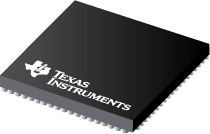达芬奇数字媒体处理器338-NFBGA -40至85
PDF, 78 Kb, 档案已发布: Dec 4, 2009
With XDM1.0, the decoder does not have separate reference and display buffers. The reference buffers of the decoder are used for display as well. This helps in reducing the overall DDR utilization and DDR b/w.However, this new arrangement changes the overall buffer management of the application. Now the application needs to manage the display and reference buffers using the new XDM 1.0 APIs. Thi
PDF, 82 Kb, 档案已发布: Apr 29, 2010
Texas Instrument's TMS320DM365 H.264 video encoder is a flexible implementation of the H.264 video encoder standard. It supports various profiles and features, each of which can be independently selected, set or controlled. This flexibility enables the TMS320DM365 H.264 video encoder to be used in a variety of different applications. This application report lists the different parameters that can
PDF, 75 Kb, 档案已发布: Dec 9, 2009
You will significantly enhance video encoder quality by incorporating external input/feedback from the system. Additionally, the robustness of the video codec will also be vastly improved. The video codec can utilize such information to react quickly and adapt to changing dynamics of the input video signal. This greatly enhances the end-user experience as the video encoder can prioritize the more
PDF, 99 Kb, 档案已发布: Dec 4, 2009
TI codec software was traditionally run on a DSP, which had DSP/BIOSв„ў software kernel foundation as an operating system. With the new range of upcoming SOCs , where the architecture is getting more hardware accelerator centric, the use of digital signal processing (DSP) is reduced. The codec can operate directly from the main processor, which also hosts the primary operating system. Theref
PDF, 61 Kb, 档案已发布: Sep 10, 2009
This application report discusses the power consumption of the Texas Instruments TMS320DM36x digital media System-on-Chip (DMSoC). Power consumption on the DM36x device is highly application-dependent; therefore, a spreadsheet that estimates power consumption is provided along with this document. To obtain good results from the spreadsheet, realistic usage parameters must be entered (see Section 2
PDF, 311 Kb, 档案已发布: May 10, 2012
PDF, 79 Kb, 修订版: A, 档案已发布: Jun 2, 2011
For purposes of comparison, this application report describes the key features of the TMS320DM36x (DM36x) and the TMS320DM35x (DM35x) digital media processors.
PDF, 35 Kb, 档案已发布: Apr 11, 2010
PDF, 125 Kb, 修订版: A, 档案已发布: Sep 11, 2009
PDF, 5.8 Mb, 档案已发布: Jul 29, 2009
This application report provides information on the DM36x throughput performance and describes the DM36x System-on-Chip (SoC) architecture, data path infrastructure, and constraints that affect the throughput and different optimization techniques for optimum system performance. This document also provides information on the maximum possible throughput performance of different peripherals on the So
PDF, 104 Kb, 修订版: A, 档案已发布: Sep 11, 2009
PDF, 1.2 Mb, 修订版: A, 档案已发布: Jul 8, 2009
PDF, 165 Kb, 档案已发布: Aug 4, 2009
TMS320DM365,TPS62111,TPS62290,TPS62231 High-Vin, High-Efficiency Power Solution Using DC/DC Converter for TMS320DM365
PDF, 151 Kb, 修订版: A, 档案已发布: Sep 11, 2009
PDF, 93 Kb, 修订版: A, 档案已发布: Jul 17, 2008
This application report motivates the way the DDR high-speed timing requirements are now going to be communicated to system designers. The traditional method of using data sheet parameters and simulation models is tedious. The system designer uses this information to evaluate whether timing specifications are met and can be expected to operate reliably.Ultimately, the real question the hardwa
PDF, 814 Kb, 修订版: G, 档案已发布: Jul 27, 2017
As modern bus interface frequencies scale higher, care must be taken in the printed circuit board (PCB) layout phase of a design to ensure a robust solution.
